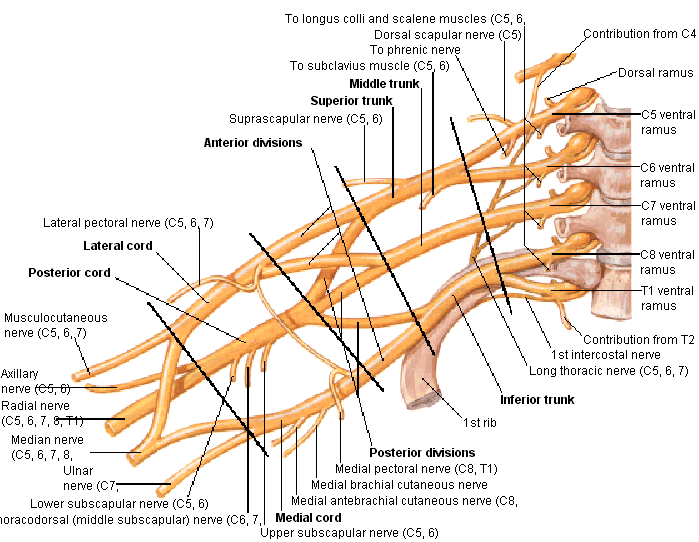Brachial Plexus
BRACHIAL PLEXUS
Description(1)
The Brachial Plexus is a network of nerves stemming from the cervical spine and upper thoracic spine, from level C5 through T1. The long thoracic nerve has an origin from C5-C7, with the dorsal scapular nerve branching off the C5 distribution of the long thoracic nerve. The trunks are formed by the joining of C5 and C6 (Upper Trunk), C7 alone (Middle Trunk), and C8 and T1 joining (Lower Trunk). Each of the three trunks divide into anterior and posterior divisions. The anterior/ posterior divisions separate nerve fibers that innervate flexor groups versus extensor groups. The two anterior divisions originating from the upper and middle trunks combine to form the Lateral Cord. The three posterior divisions combine, one from each trunk, to form the Posterior Cord. The lower trunk splits to provide one of the posterior divisions and one anterior division. The anterior division becomes the Medial Cord. The cords then branch to become the main branches. The lateral cord branches to become the Musculocutaneous Nerve (C4,5,6). The lateral and medial cord branch to become the Median Nerve (C5-8, T1). The medial cord also branches to for the Ulnar Nerve (C8-T1) and the Medial antebrachial cutaneous nerve (C8-T1). Other smaller nerves originate from the roots, trunks and cords.
Injuries(1)
Injury to the brachial plexus can be very problematic because the nerves branching off of the plexus provide innervation to the upper extremity. Clinical signs and symptoms vary with which area of the plexus is involved, and can generally result in paralysis or anesthesia. Brachial plexus injury can occur in a variety of ways. During birth, excessive stretching of the neck or pulling the upper extremity can result in an upper brachial plexus injury or inferior trunk, respectively. An adult can injury the brachial plexus by landing on the neck in a way that separates the neck from the shoulder, or from a traction injury. The most common forms of injury include: Erb Palsy (upper brachial plexus palsy) and Klumpke’s Palsy (lower brachial plexus injury). The characteristics of Erb Palsy include a waiter’s tip position (arm lies in internal rotation, elbow extended, forearm pronated, wrist and fingers flexed). The characteristics of Klumpke’s Palsy include paralysis and atrophy of the hand muscles and flexors of the wrist.
Brachial Plexus Block(2)
A brachial plexus block allows a surgeon to operate on an upper extremity without the use of a general anesthetic, when combined with a tourniquet. The location of the injection is between the posterior border of the sternocleidomastoid and the clavicle. The axillary sheath surrounds the axillary vein, axillary artery, and three cords of the brachial plexus. When the injection takes effect, the muscles and skin innervated by the cords found in the sheath are anesthetized.
Other Important Information
A useful mnemonic to remember the path of the brachial plexus is Randy (Roots) Travis (Trunks) Drinks (Divisions) Cold (Cords) Beer (Branches).
Useful websites/ more information: Learning the Brachial Plexus, BP Video 1, BP Video 2, Brachial Plexus Block
Recent Related Research
Saliba S, Saliba EN, Pugh KF, Chhabra A, Diduch D. Rehabilitation considerations of a brachial plexus injury with complete avulsion of C5 and C6 nerve roots in a colege football player: A Case Study. Sports Health. 2009:1(5): 370-375.
References
1. Dutton M. Orthopaedic Examination, Evaluation and Intervention. New York, NY: McGraw-Hill;2004.
2. Moore KL, Dalley AF. Clinically Oriented Anatomy, 5th ed. Philadelphia, PA:Lippincott Williams and Wilkins;2005.







